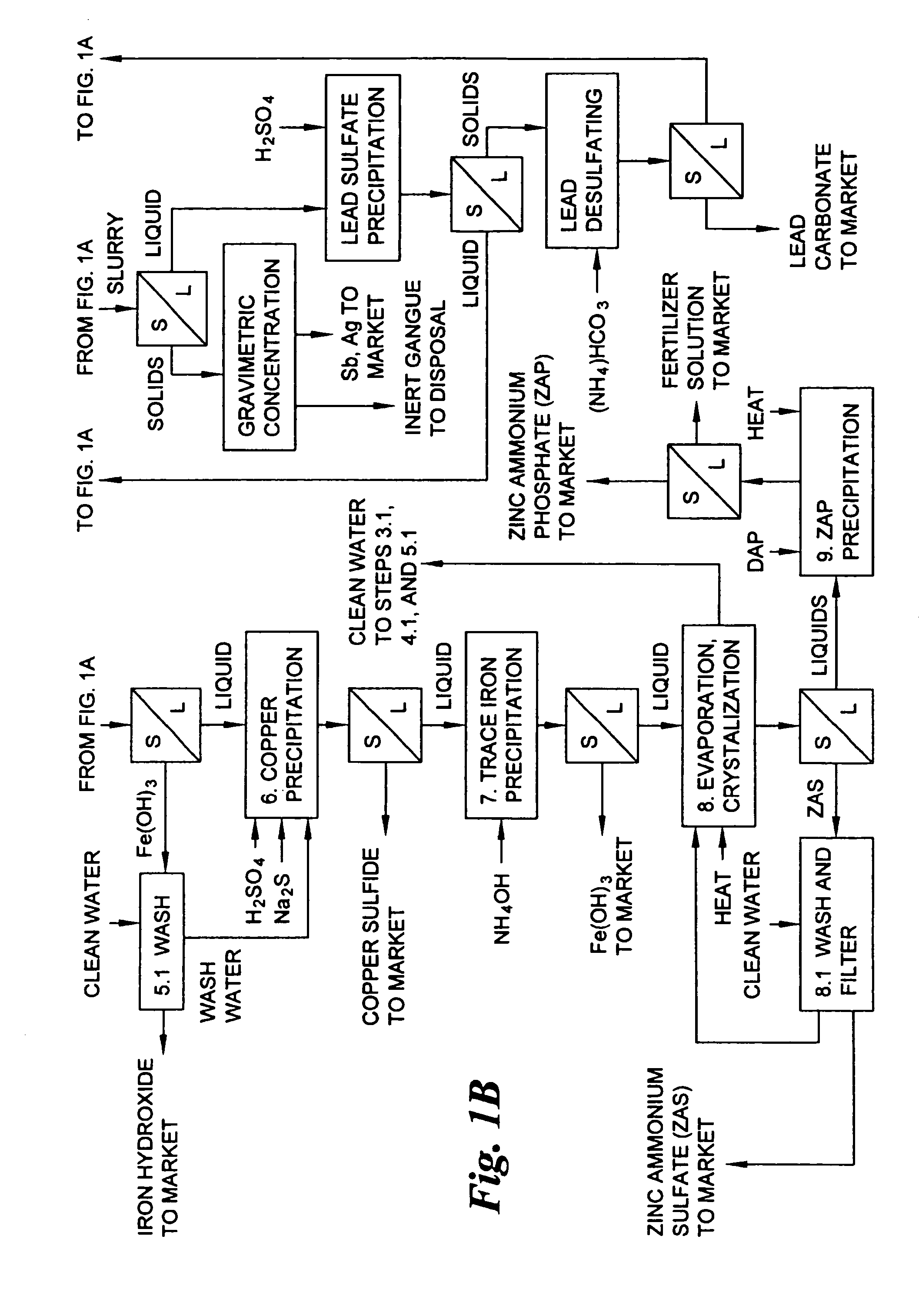The few lead smelters in the world that currently purchase and process ores containing the above-mentioned toxic metals penalize such ores and concentrates to the financial detriment of the producer.
The resulting
sulfur dioxide gas and oxides of
arsenic and antimony are pollutants that must be removed from the gas
stream, often at significant cost.
A leach circuit employing a modification of U.S. Pat. No. 5,096,486 was installed in Idaho to process silver-bearing complex sulfide ores (previously processed with alkali to remove antimony) using a
nitric acid /
sulfuric acid /
oxygen pressure leach process, but that circuit was discontinued because, among other reasons,
operational costs exceeded the simple alternative of selling concentrates to a near-by smelter.
At the present time, there are no plants employing nitric acid pressure leach methods to process silver-bearing complex sulfide ores.
Simple gold-bearing
sulfide minerals such as
pyrite and
arsenopyrite rarely contain more than small amounts of gold and silver per
ton of concentrate, thus the method proposed by Raudsepp, et al, not only was un-economic for use with such low-grade ores and concentrates, it did not address the metallurgical problems associated with extracting silver from high-grade, complex silver-bearing sulfide ores, such as the bulk of silver concentrates traded on the world market today.
However, only the most simple sulfide ores respond to the Posel method with anything approaching the high silver recoveries described.
This entrained silver is difficult to separate from the beaded sulfur.
Moreover, any error in the cooling of the leach
slurry, or a variation in the
mineralogy of the ore, will result in the formation of “gummy” sulfur, which has a tendency to precipitate almost all of the silver from the pregnant solution due to an electrochemical exchange between elemental sulfur and unreacted
pyrite in the
slurry, causing the electro-deposition of silver on the surface of the elemental “gummy” sulfur.
Furthermore, even were error completely overcome and the formation of “gummy” sulfur eliminated, not all the elemental sulfur will form beads of sufficiently
large size to be collected by a screen; a significant portion of the elemental sulfur will report to the tails as finely divided sulfur, which would complicate the disposal of, or further
processing of, the tails.
All the lead and antimony contained in the mineral concentrates would report to the tails as potentially toxic compounds, making untenable the statement by Posel that such tails could be sold to the road-
building industry.
However, diligent investigation shows that Kunda's assertions of high silver recovery using the method described cannot be duplicated in silver-bearing concentrates where the preponderant mineral is any one of the sulfosalts containing antimony, which would include many of the complex silver ores produced around the world.
The method described by Kunda could only be used on a specific type of relatively non-complex silver concentrate and is not useful for the treatment of complex silver ores, especially those containing antimony.
Kunda describes the
precipitation of
zinc sulfide from a pH neutral solution, however, it is well known to those with a passing knowledge of the art, that under such conditions,
zinc sulfide is extremely slimy and requires extraordinary effort to filter.
Another drawback to the method described by Kunda would be the presence of finely divided elemental sulfur in the oxidized tails of the leach reaction, plus insoluble
oxide compounds of lead and antimony.
This elemental sulfur would be difficult to remove and would hinder any attempt to further recover lead or antimony from such tails by either pyrometallurgical or hydrometallurgical methods.
Because of the risk of arsenic and other toxic metals leaching from
tailings ponds into the environment, and the undeniable fact that
tailings ponds have been known to break with dramatically negative consequences for the environment, operations that require
tailings ponds may be restricted in the future.
Among the problems associated with the method proposed by Anderson, et al, are i) the very large quantity of sulfuric acid used in the pressure leach (1,931 kgs of sulfuric acid per 1,000 kgs of concentrate) that must be later neutralized at relatively high cost and disposed of into the environment; ii) the objectionable
discharge of possibly unstable toxic compounds into the
liquid phase of a tailings pond, from which they might leach into the environment; iii) the presence of elemental sulfur in the tails; and iv) the presence of
lead sulfate and oxides of arsenic and antimony in the tails.
However, the use of
silver salts in the manner proposed by McElroy, et al, is both uneconomical and impractical, given that the silver would report to the tails as insoluble compounds.
Given that, per weight basis, silver is a
precious metal at least 100 times more costly than copper, to send such amounts of valuable silver into tailings would be commercially unthinkable.
 Login to View More
Login to View More 

